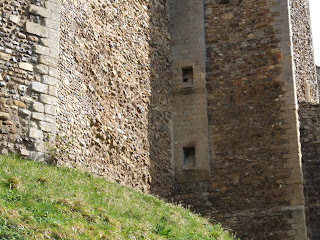Photo: Framlingham Castle privy chute (Holly Stacey)
It used to be one of those taboo human
necessities that history books of an older generation would often
slide over with a quick reference of architectural purpose within a
castle, perhaps a word or two about its necessity, and then the
historian quickly moves on to a more palatable subject. After all,
dwelling on where one does one's dirty deeds isn't well respected, or
at least, it certainly wasn't in the past. Enter a new generation of
historians without fear of taboo, where every subject of history is
of interest, including the humble and stinky corners of the castle.
So the question is, what was a castle loo like and how did it work?
In
manor houses and lesser homes, folk would use a chamberpot to relieve
themselves which would then be dumped out but the castle had a
different system. Instead of using the privacy of one's own bedroom
or bed chamber, one would visit the garderobe, or privy, which would
most often be shared with other castle inhabitants. The garderobe was
a room where, well, clothing was often kept. It might seem random and
crazy that it would end up being synonymous with a privy. 'Hold on
love, I've just got to pop to the closet to do a poo,' just doesn't
sound very alluring. But the garderobe, garder being French for 'to
keep clothes', is certainly the origin of the word wardrobe and in
many castles, the best place to keep finery was where moths were
deterred from the strong ammonia stench that emanated from the small
rooms. Although there were more places to pee than just the garderobe
or jake – believe it or not, fireplaces were used as mens' urinals.
In Wendy J Dunn's article on privy's, she writes, 'Even
at the beautiful palaces of this period there were ‘pissing areas’
allotted for members of the court. In their first weeks at the court
of Henry VII, it shocked Catherine Aragon’s Spanish ladies, and no
doubt sixteen-year-old Katherine herself, to witness courtiers
attending to their bodily needs when and wherever necessary (Emerson
1996, p. 54).' Also in Wendy's article on privys and castle pissing
places, she goes on to state that the larger fireplaces were by far
the more preferred.
 |
| Old Sarum's cesspit credit English Heritage |
Framlingham Castle, like many large
castles without a moat or river to take the waste away, only had a
chute down the hill which today can be accessed easily on a visit to
the site where a visitor can see up the chute from the outside and
imagine how well the waste could have piled up. According to the
castle guidebook (page 12), 'Latrines were reached through small
doorways in the curtain wall and expelled their contents down chutes
out into the ditch below. An example of this can be seen in tower 13.
On the east side of the castle, vaulted chambers can be seen in tower
7. Elsewhere, the holes for floor beams can be seen, for example, in
the gate-tower and in the corner tower 4.' It doesn't exactly paint a
pretty picture for these iconic structures. Nevertheless, the privy
for larger structures was necessary as with a larger population, the
chamberpot system of poo and dump wasn't as effective; in other
words, the common privy allowed for excrement to be gathered, rotted
and re-used if not just swept away by a body of water or left to be
eaten by a moat's population of carp. Anyone for a fish supper?
 |
| Photo credit Holly Stacey - Framlingham Castle |
______________________________________________________________
References
Dunn, Wendy - http://wendyjdunn.com/tudor-articles/being-privy-to-tudor-privies-by-wendy-j-dunn/
Matarasso, Francois, 'The English Castle; Cassell plc, London, 1995
Platt, Colin, 'The Castle in Medieval England & Wales'; Chancellor Press, London, 1995
English Heritage Guidebooks – Framlingham Castle
English Heritage Blog – Toilets through time
BBC.co.uk – Life in the Castle
________________
Lizzy Drake has been studying Medieval and Tudor England for over 15 years and has an MA in Medieval Archaeology from the University of York, England. She has been writing for much longer but the Elspet Stafford Mysteries began her writing careen in the genre. The First Elspet Stafford book, A Corpse in Cipher - A Tudor Murder Mystery, is available now.
When not writing or researching, Lizzy can be found reading or gardening. She balances time between her two homes in Essex, UK and California.
You can follow her on Twitter (Lizzy Drake@wyvernwings)



Interesting! The word garderobe is still used in Norwegian for wardrobes and changing rooms.
ReplyDeleteI knew about the garderobes, but I hadn't heard of the fireplace usage! Doesn't surprise me, though. Well, as for the common privy, it sounds like an excellent case of recycling. Pity about the waste of urine, though; the Romans could have suggested a good use for that.
ReplyDelete